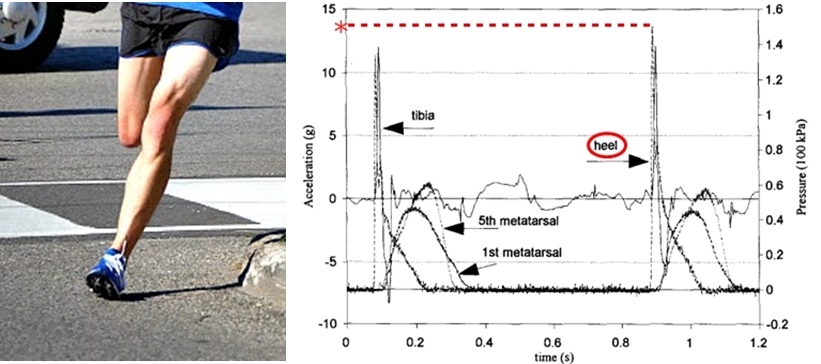Unlike forefoot running, heel strike running is classified as a collision between the body and the ground because the body comes to a sudden stop, resulting in the generation of the heel strike transient.
The heel strike transient is not produced in forefoot running because the body does not abruptly stop at touchdown.
Since there is no heel strike transient in forefoot running, less shock loading passes through the skeleton, peak accelerations are very low, and overall dynamic loading on the body diminishes.
Heel Strike Transient: Why it’s so Damaging
After the heel strike transient is generated, it converts into a vertical shockwave that channels through the body to the head.
Because of it’s high magnitude, the heel strike transient is assumed to be the underlying cause of most running injuries. In fact, the heel strike transient is so damaging, numerous studies developed mathematical models in attempt to explain how the impact transient can be controlled, but this area of research has been a rocky road. Why?
With all the novel footwear technologies being manufactured, running is still known as a high impact and injurious activity.
The acceleration associated with the heel strike transient is identified as a large sharp spike of the ground reaction force that occurs approximately 12 g in magnitude and is six times greater than normal walking gait.

Other models have found that heel strike transients can run as high as 60 g of which the natural shock absorbing properties in the foot reduced this value to 12 g.
This is how the magnitude of the heel strike transient exceeds the absorbing properties of the heel pad which allows the transient to penetrate through the body so easily, even with a cushioned heeled running shoe.
Another serious problem is that the human body has not evolved strategies of landing cushioning properties to fully attenuate the heel strike transient.
Even though certain body segments such as the foot, the knee and even the head, have shock attenuation properties, the heel strike transient is never 100% attenuated during heel strike running. This is why an external source, such as a running shoe, is needed for shock protection.
The problem with the traditional running shoe is a design flaw: the cushioned, elevated heel, in which shoe manufacturers fail to take into account that it causes heel strike. Kind of sounds like the running shoe industry has played a cruel trick on us.
To every runner’s relief, the best way to reduce the shockwave magnitude when running is by eliminating the heel strike transient simply by avoiding heel strike.
Landing on your forefoot first during running will not only eliminate impact transients, but reduces the overall rates and magnitude of the ground reaction force as well.
More on Heel Striking:
- Why Your Back Hurts After Running
- Why Heel Strikers Get Sore Knees and Forefoot Strikers Don’t
- Heel Strike Transient Implicated in Tibial Fractures
- How Heel Striking Causes Soft Tissues to Swell
- Minimalist Running Shoes
References:
Bobbert, MF., Yeadon, MR and Nigg, M. Mechanical analysis of the landing phase in heel-toe running. J Biomech, 1992; 25, 223-243.
Kim, W., Voloshin, AS and Johnson, SH. Modeling of the heel strike transients during running. Human movement science, 1994, 221–224.
Bretta Riches
BSc Neurobiology; MSc Biomechanics candidate, ultra minimalist runner & founder of RunForefoot. I was a heel striker, always injured. I was inspired by the great Tirunesh Dibaba to try forefoot running. Now, I'm injury free. This is why I launched Run Forefoot, to advocate the health & performance benefits of forefoot running and to raise awareness on the dangers of heel striking, because the world needs to know.
Latest posts by Bretta Riches (see all)
- Can You Run In Barefoot Shoes? Yes, But DON’T Heel Strike! - 21/07/2024
- Why Cushioned Running Shoes Are Really Bad for Your Feet - 19/07/2024
- Do Cushioned Running Shoes Cause Injuries? - 17/07/2024


Leave a Reply